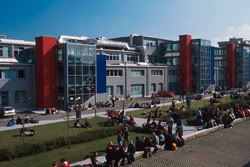Politechnico di Milano Milan - June 9, 2011
Of all the educational institutions we have visited during our time in Italy, Politecnico di Milano stands out as one of the most highly developed schools for students of engineering and design. Originally called "Istituto Tecnico Superiore", Politecnico was established in 1863. The school has an extensive history that has greatly influenced the way in which it operates to this day.
We were personally welcomed to Milan by the dean of the school, who explained to us the general layout of the Politecnico Network. Politecnico is divided into 7 different campuses that are scattered across Italy, each dedicated to a specific range of studies. We visited the Bovisa campus, which itself is divided into two campuses, one for industrial engineering and the other for design and architecture.
Politechnico schools actively focus on several areas of education and research including; Building Construction, Infrastructure and Landscape, Products and Industrial Processes, and Information Society Technologies. There are 16 departments which are active in the Politecnico di Milano. The department that is most closely linked to our School of Industrial Design is entitled 'Industrial Design, Arts, Communication and Fashion, (INDACO). The Politecnico has also been divided into a group of schools that organize the studies of specific bachelor degrees and masters courses. Within these 9 schools there are six designated for engineering, two for architecture and one for design.
A view of the Bovisa Campus.
As a quick over-view of the numbers:
- 7 Campuses across Italy
- 2 sub-campuses within Bovisa (the campus we visited)
- 13 Research Areas
- 16 Departments
- 9 Schools – 1 School of Design
- 117 Design Professors
- 3000 + Design Students
- 78% of designers in Italy graduated from the Politecnico di Milano
INDACO is organized into a great variety of groups, some of which are Design Knowledge, Design Research Culture, Design and System Innovation for Sustainability, Drawing for Industrial Design, Usability and Quality of Industrial Products, Light & Colour, Virtual Prototyping, and Reverse Modelling. The students participate in a combination of lectures and labs, receiving both a conventional education and hands-on experience. A more detailed overview of the university structure and a class list can be found on their website at: http://www.english.polimi.it/
Visiting Politecnico di Milano was a very enlightening experience. It was interesting to see a design school in a country where there is generally more emphasis is placed on the design community. Politechnico is a very complex organization that supports creativity and innovation through a diverse selection of studies.
- Laura M, Jessica and Kelvin


No comments:
Post a Comment